PREVIOUS
Chandrayaan Missions of India – Part 4
September 1 , 2023
839 days
3718
0
(இதன் தமிழ் வடிவத்திற்கு இங்கே கொடுக்கவும்)
Chandrayaan 3
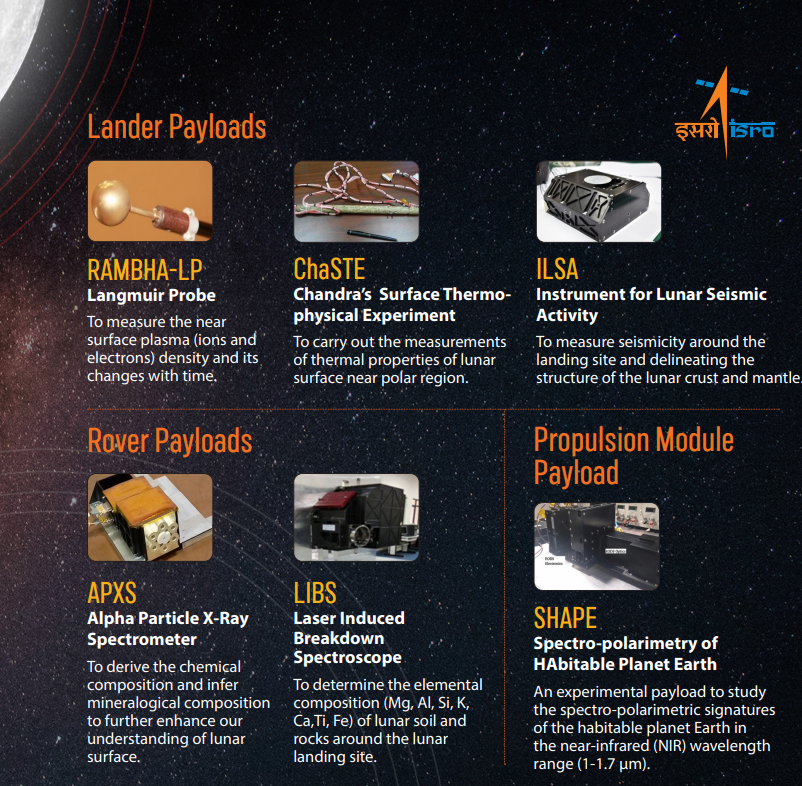
- The Indian Space Research Organisation (ISRO) has made significant progress in its ambitious Chandrayaan-3 mission.
- It aims to demonstrate the capability of a soft landing on the Moon.
- It was following the setback of the Chandrayaan-2 mission.
- Chandrayaan-3 is India's third lunar mission.
- It is second attempt at achieving a soft landing on the moon's surface.
- The mission took off from the Satish Dhawan Space Center (SDSC) in Sriharikota on July 14, 2023, at 2:35 pm.
- India now joins the United States, Russia, and China as one of the few countries to successfully land on the Moon.
- It will demonstrate India’s end-to-end capability in safe landing and roving on the lunar surface.
Objectives
- It has indigenous lander module, propulsion module and a rover.
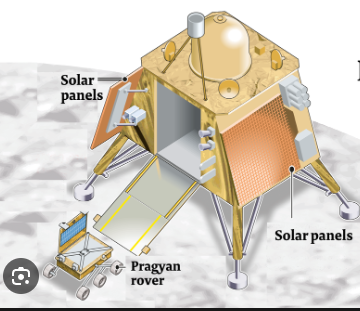
Safe and Soft Landing
- The primary objective of Chandrayaan-3 is to achieve a safe and soft landing of the lander on the surface of the Moon.
- This mission aims to successfully land the lander module on the lunar surface without any issues.
Demonstration of Rover’s Capabilities
- Chandrayaan-3 aims to demonstrate the capabilities of the rover.
- It is showcasing roaming and exploration abilities on the lunar surface.
- The rover will be deployed after the successful landing of the Lander.
Moon’s In-Site Scientific Observations
- The mission seeks to conduct in-site scientific observations and experiments.
- It is help to get better understand the composition of the Moon.
- This includes analyzing the chemical and natural elements, soil, water, and other resources available on the lunar surface.
- These observations will contribute to expanding our knowledge of the Moon’s composition.
- It provides insights into the Moon’s history and evolution.
Demonstrating Soft Landing and Scientific Exploration
- By accomplishing this feat, India aims to join the exclusive group of nations that have successfully landed on the Moon.
- The mission also intends to conduct chemical analyses, gather valuable scientific data, and contribute to advancements in lunar research.

Aims
- To conduct in-situ (on-site) scientific experiments.
- To measure the plasma density fluctuations near the lunar surface.
- To carry out the thermal traits of the moon's frigid polar zones.
- To measure seismic activity, unveiling lunar crust-mantle configuration
- To understand the dynamics of the Moon system
- It also aims to develop and demonstrate new technologies required for interplanetary missions.
- The success of the mission will make Chandrayaan-3, the world’s first mission to soft-land near the lunar South Pole.
- India is the fourth country to soft-land on the moon.
Background
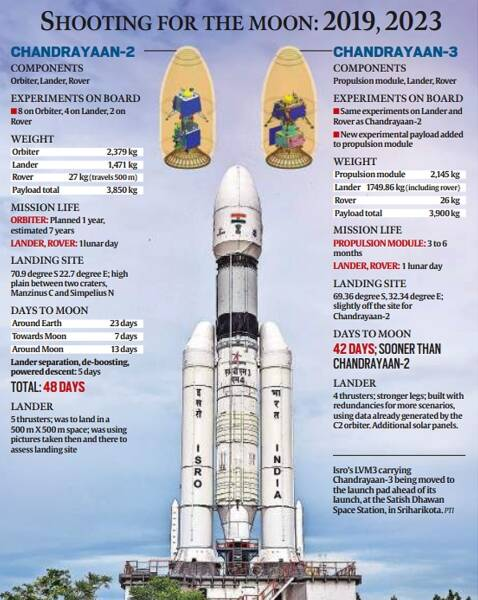
- Chandrayaan-2 is resulting in a setback for ISRO.
- However, the organization used this setback as an opportunity for learning and improvement.
- It aims to address the shortcomings of its predecessor and accomplish.
- It is a successful soft landing on the lunar surface.
- Chandrayaan-3 is a continuation of Chandrayaan-2
- Chandrayaan-2 was launched in July 2019.
- It has as its goal to place a rover on the lunar South Pole.
- The Satish Dhawan Space Centre in Sriharikota has launched the mission on July 14, 2023, using a Launch Vehicle Mark 3 (LVM3).
- India was ready to launch Chandrayaan 3 in 2022, but due to the COVID-19 pandemic there was delay in its production.
- The orbiter, rover, and lander were all included in the design of the Chandrayaan 2 spacecraft by ISRO.
Chandrayaan-3 Spacecraft
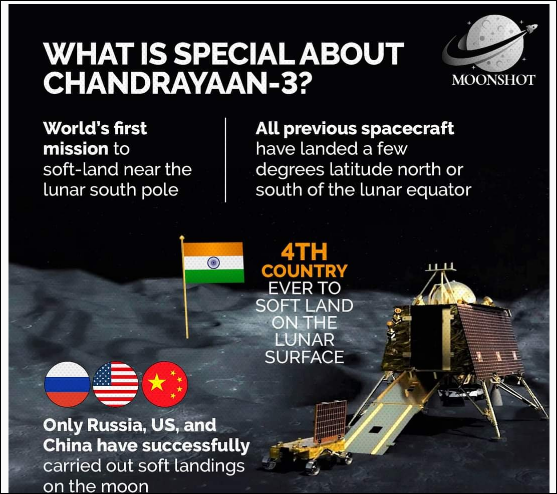
Three essential components of Chandrayaan-3 spacecraft
- The Lander module, the propulsion module, and a rover are this three.
- The Lander module is designed to achieve a soft landing on the Moon.
- It deploys the rover for scientific exploration.
- The rover will conduct chemical analyses.
- It is to carry scientific payloads to enhance our understanding of the lunar surface.
- Additionally, the propulsion module plays a crucial role in transporting the lander and rover to the lunar orbit.
Launch Vehicle Mark-III (LVM-3)
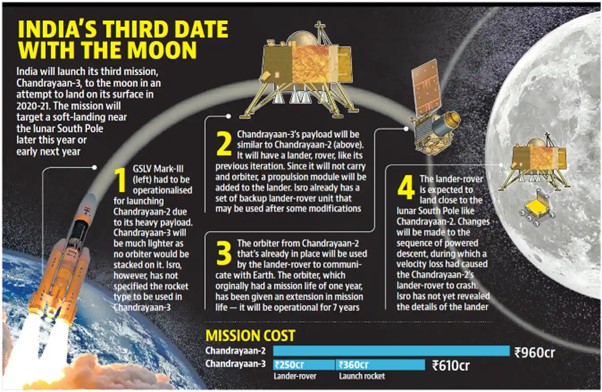
- It is India’s most powerful rocket developed by ISRO.
- It serves as the launch vehicle for the Chandrayaan-3 mission.
- Earlier known as ‘GSLV Mk-III’, it is the most powerful rocket in the ISRO’s stable.
- Launch Vehicle Mark-III (LVM3) is a three-stage medium-lift launch vehicle developed by ISRO.
- The 3-stages include two solid boosters (S200), the core liquid fuel-based stage (L110), and the cryogenic upper stage (C25).
- C25 uses cryogenic engine (CE20).
- It can carry a payload of up to 8,000 kilograms to a low-Earth orbit (LEO).
- It can carry 4,000 kilograms of payload to a geostationary transfer orbit (GTO).
- LVM-3 was used also in launching Chandrayaan-2.
- Standing tall at 43.5 meters with a diameter of 4 meters, it possesses a lift-off mass of 640 tonnes.
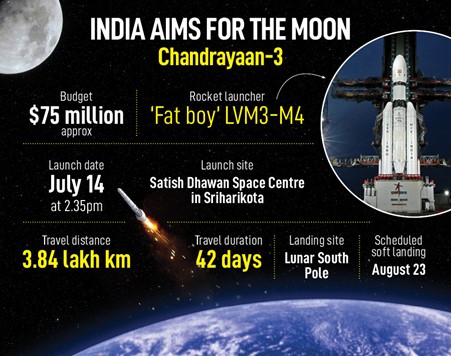
Mission Components
- The 3,900-kilogram Chandrayaan-3 spacecraft consists of three major modules: the Propulsion module, Lander module, and Rover.
- The lander, named Vikram, and the rover, named Pragyaan, are similar to their counterparts in Chandrayaan-2.
- But they have undergone upgrades for improved reliability.
- The mission’s budget is Rs. 615 crore.
Mission Modules, Design and Approach
- Chandrayaan-3 consists of three main components
Propulsion Module
- The propulsion module is responsible for carrying the lander and rover configuration to the lunar orbit of 100 kilometers.
- It is a box-like structure with a large solar panel and an intermodular adapter cone.
- It acts as a mounting structure for the lander.
- Additionally, it carries the SHAPE payload.
- It studies spectral and polarimetric measurements of Earth from the lunar orbit.
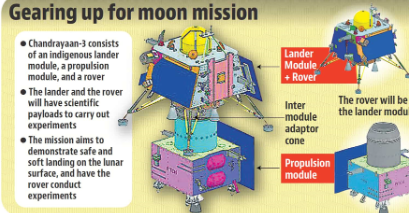
Lander
- The lander module is designed for a soft landing on the lunar surface.
- It has a box-shaped structure with four landing legs and four landing thrusters.
- The lander carries the rover and various scientific instruments for in-site analysis.
- It has undergone improvements in terms of structural rigidity, impact legs strength, and instrumentation redundancy compared to its predecessor.
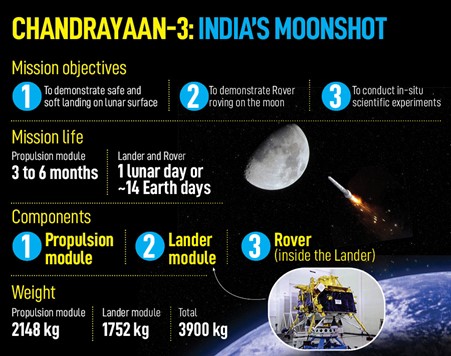
Three payloads
Chandra’s Surface Thermophysical Experiment (ChaSTE)
- It measures thermal conductivity and temperature of the lunar surface.
Instrument for Lunar Seismic Activity (ILSA)
- It measures seismic activity around the landing site.
Langmuir Probe (LP)
- It estimates plasma density and its variations.
Rover
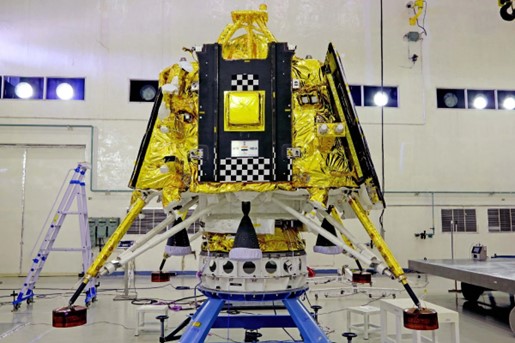
- The Chandrayaan-3 rover is a six-wheeled vehicle weighing 26 kilograms.
- It is equipped with scientific instruments, including cameras, spectrometers, and a drill.
- The rover has a range of 500 meters.
- It is designed to communicate with the lander and the ground control team in India.
- Its expected lifespan is one lunar day, equivalent to 14 Earth days.
- The rover aims to make significant scientific discoveries.
- It includes studying the lunar surface composition, detecting the presence of water ice in the lunar soil, investigating lunar impacts’ history, and studying the Moon’s atmosphere evolution.
Modifications and Precautions
- Chandrayaan-3 has undergone modifications by ISRO to enhance reliability compared to its predecessor, Chandrayaan2.
- The lander Vikram has been upgraded and carries additional fuel.
- It helps to ensure a successful landing and stay on the intended path to the lunar surface.
- The craft has undergone rigorous testing.
- It is incorporates numerous safety measures to increase the mission’s chances of success.
Lunar Orbit
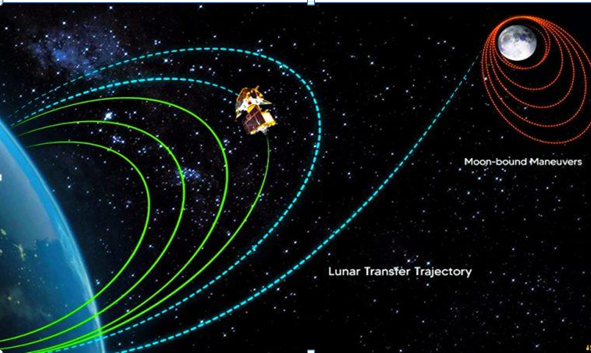
- The module enters lunar orbit and the reverse will happen.
- Loop-by-loop the spacecraft will get closer to the moon.
- It will reaches until a circular path 100 km above the moon's surface before the lander separates.
- On the Moon - the lander will soft land at a specified lunar site (lunar South Pole) and deploy the rover.
- The rover will explore the lunar terrain for 14 Earth days (1 lunar day).
- It will carry out in-situ chemical analysis of the lunar surface.
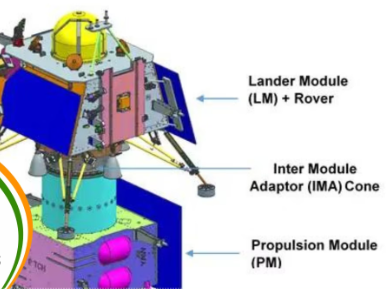
-------------------------------------
Leave a Reply
Your Comment is awaiting moderation.


